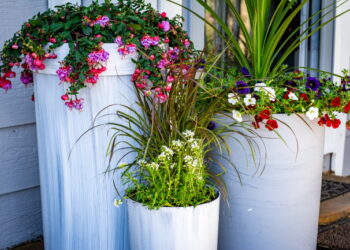Are you down with the skyrocketing grocery bills lately? Do you know the average household in America spends over $9,343 annually on food eaten at home in 2022?
And with inflation driving up costs, experts forecast that the number will inflate much further in 2024 and beyond.
Yet you can beat back that budget strain by getting into home food production. Converting just a small outdoor or indoor space for growing fruits, veggies, and herbs can yield big savings. Plus, there are a lot of benefits to growing your own food. Let’s take a look at that in this blog.
What Does It Mean to Grow Your Own Food?
Growing your own food simply refers to planting and cultivating produce rather than purchasing it. This includes fruits, vegetables, herbs, and more. Instead of relying solely on stores and markets, you can become self-sustainable by raising homegrown produce, even in limited spaces.
Home food production used to be quite common before large-scale commercial agriculture dominated the food system. However, many people are returning to small-scale cultivation for personal use. This offers an array of benefits compared to store-bought produce.
Why Grow Your Own Food?
Here are some of the best motivations for growing food yourself:
Significant Cost Savings
One major incentive for home cultivation is the money you’ll save. The cost of buying produce, especially organic, continues rising. Growing your own can slash grocery bills since you’ll have an ongoing supply. Once you cover initial garden investments, the rest is mostly time and care.
Superior Freshness and Flavor
Another big benefit is taste. So far, in the United States, most fruits and veggies are from overseas. The implication is that most of these fruits and veggies begin losing nutrients and flavor immediately after harvesting. However, homegrown produce eaten right after picking delivers unparalleled freshness and peak flavor levels store-bought items simply cannot match.
Know Your Food Source
Consumer awareness about our food system, additives, and production methods increases demand for transparency. If you grow crops yourself, you’ll know exactly where they originated and what’s in them. You’ll control factors like pesticides, genetic engineering, synthetic fertilizers, and can ensure organic practices.
Increased Access to Healthy Foods
Growing crops at home lets you take charge of nutrition. You can cultivate super healthy choices like leafy greens, tomatoes, carrots, berries, and beans that would otherwise prove expensive from natural grocers. Homegrown food gives you access to the freshest, chemical-free produce that packs high densities of vitamins, minerals, and antioxidants to enhance your health.
Enjoyable Hobby with Many Rewards
Finally, learning to grow food can simply be fun and rewarding! Planning the garden, nurturing seeds, watching things grow over seasons, and finally enjoying the fruits of your labor is incredibly gratifying. It is an exciting hobby the whole family can enjoy together.
How to get Started with Growing Your Own Food
If the many benefits have you ready to give growing your own food a try, here is a quick run-down of what’s involved:
Choose What to Grow
Begin by deciding which plants make sense for your situation – available space, local climate, time commitments, and eating preferences should guide selections. Focus on crops that store well or replenish through seasons.
Determine Planting Location
Figure out the optimal garden site based on sunlight, drainage, space, access to water, and convenience. Gardens can utilize yards, containers on balconies/patios, or even windowsills!
Prepare and Amend Soil
Good fertile soil is essential, so remove weeds, mix in compost, adjust pH, enrich with organic matter, and ensure adequate drainage before planting.
Select Seeds or Seedlings
Shop for quality seeds or starter plants that are ideal for your region. Determine if beginning from seed or opting for established seedlings is best for different crops.
Sow Seeds or Transplant Seedlings
Once soil prep is done and the weather warms up, you’re ready to sow seeds directly or transplant seedlings at the correct depths and spacing based on plant needs.
Provide Care and Maintenance
Things like watering, fertilizing, weeding, support structures, and protection from pests/diseases are vital for healthy crops as they grow. Routine care makes all the difference!
Harvest Once Ready
Finally, the fun part arrives as plants reach maturity and crops are ready for harvesting! Exact timing depends on what’s grown.
Store and Preserve Bounty
Preserve extra produce so you can enjoy fruits of labor long term. Methods like canning, freezing, drying, and cold storage extend shelf life.
Conclusion – Reap Benefits Through Home Food Production
Growing produce at home offers many advantages over purchasing all groceries. This is evident with the above benefit. So, why not start growing your own food?
The rewards are well worth the efforts involved. Start small if needed, learn as you go, and have fun with home food cultivation!








